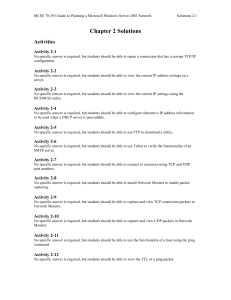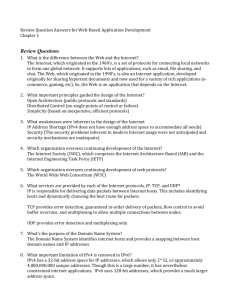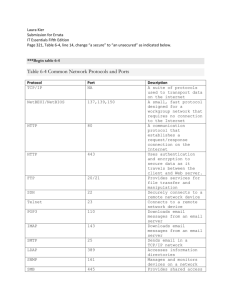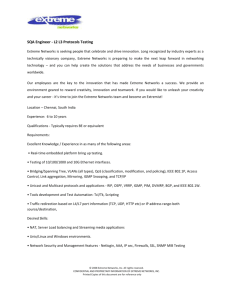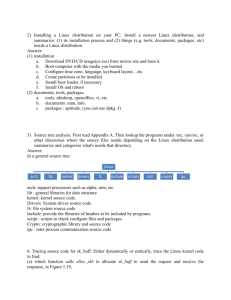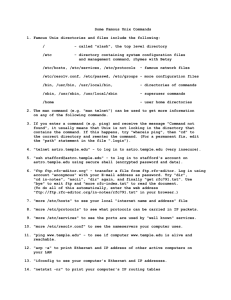Chapter 8 Solutions
advertisement
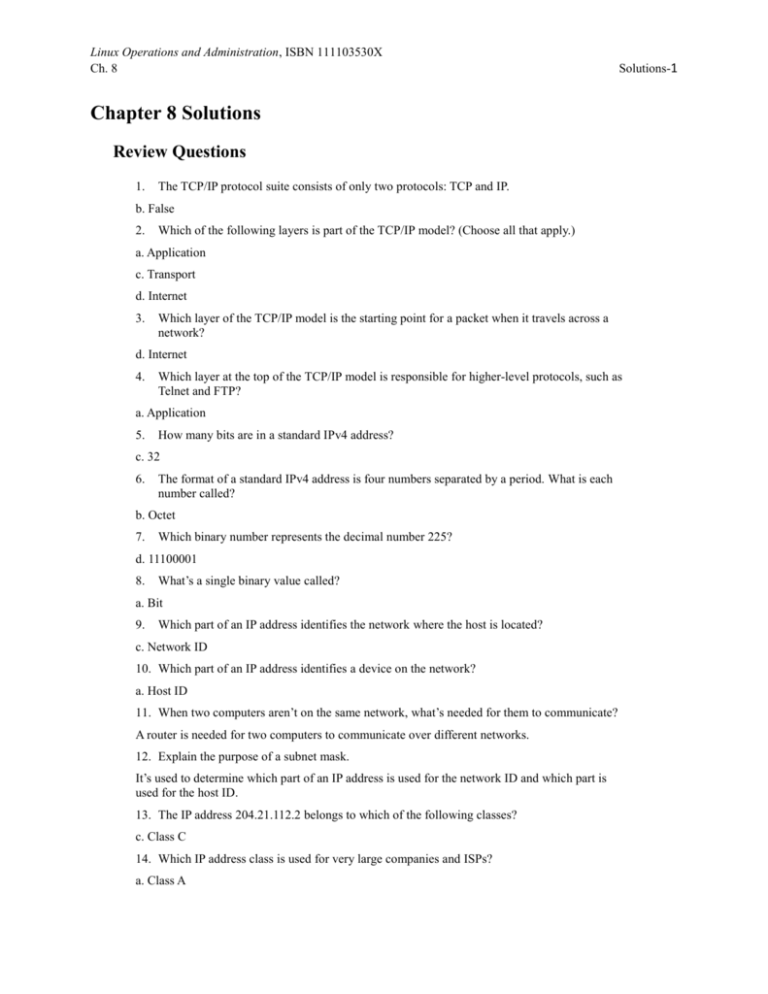
Linux Operations and Administration, ISBN 111103530X Ch. 8 Solutions-1 Chapter 8 Solutions Review Questions 1. The TCP/IP protocol suite consists of only two protocols: TCP and IP. b. False 2. Which of the following layers is part of the TCP/IP model? (Choose all that apply.) a. Application c. Transport d. Internet 3. Which layer of the TCP/IP model is the starting point for a packet when it travels across a network? d. Internet 4. Which layer at the top of the TCP/IP model is responsible for higher-level protocols, such as Telnet and FTP? a. Application 5. How many bits are in a standard IPv4 address? c. 32 6. The format of a standard IPv4 address is four numbers separated by a period. What is each number called? b. Octet 7. Which binary number represents the decimal number 225? d. 11100001 8. What’s a single binary value called? a. Bit 9. Which part of an IP address identifies the network where the host is located? c. Network ID 10. Which part of an IP address identifies a device on the network? a. Host ID 11. When two computers aren’t on the same network, what’s needed for them to communicate? A router is needed for two computers to communicate over different networks. 12. Explain the purpose of a subnet mask. It’s used to determine which part of an IP address is used for the network ID and which part is used for the host ID. 13. The IP address 204.21.112.2 belongs to which of the following classes? c. Class C 14. Which IP address class is used for very large companies and ISPs? a. Class A Linux Operations and Administration, ISBN 111103530X Ch. 8 Solutions-2 15. Which Linux command do administrators use to view TCP/IP configuration information? d. ifconfig 16. If an administrator needs to change the IP address on the first Ethernet interface to 204.21.112.101 and the netmask to 255.255.255.0, which of the following commands should be used? b. ifconfig eth0 204.21.112.101 netmask 255.255.255.0 17. Which of the following commands should a Linux administrator use to check whether local TCP/IP has been installed correctly? (Choose all that apply.) a. ping localhost c. ping 127.0.0.1 18. Which of the following commands should a Linux administrator use to send five Echo Request packets to a computer on the network? b. ping -c 5 204.21.112.50 Activities Activity 8-1 Step 2: Answers will vary. Step 3: TCP is a connection protocol responsible for keeping track of the packets and reassembling them into a single file after they’ve arrived. UDP is similar to TCP in that it uses IP to get packets from one computer to another; however, UDP is connectionless in that it doesn’t perform error checking or acknowledge that messages were sent successfully. Activity 8-3 Step 3: Students will most likely have different IP and broadcast addresses; they should have the subnet mask 255.255.255.0. Step 7: After the Linux computer restarts, the TCP/IP information changes back to what’s in the /etc/sysconfig/network/ifcfg-eth0 file. Activity 8-4 Step 1: Make sure students type ipconfig (not ifconfig) to find the IP address on a Windows machine. Step 3: Each student should get a reply when pinging 127.0.0.1, which is the loopback address, used to verify that TCP/IP is working correctly. Step 5: Students should be able to ping their Windows host machines. The number of packets will vary, depending on when they pressed Ctrl+C. Case Projects Case Project 8-1: The subnet mask for a Class B network is 255.255.0.0, and the network ID is 128.100.0.0. The Class B network could have a total of 65,534 devices on it. Case Project 8-2: Linux Operations and Administration, ISBN 111103530X Ch. 8 Solutions-3 Students might state that IP addresses have been poorly allocated and available addresses are running out. They could also mention that IPv6 offers 2128 addresses, meaning IP addresses will never run out. One important point students should include is that IPv4 was created when most people didn’t know the Internet would be what it is today. Some other benefits students might find include the following: More efficient routing Improved methods to change ISPs Improved security Better mobility support


